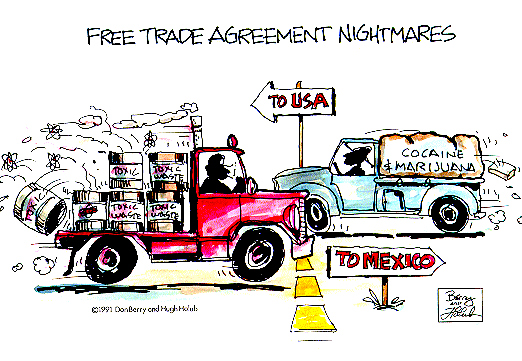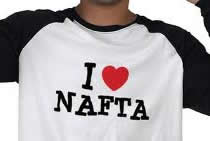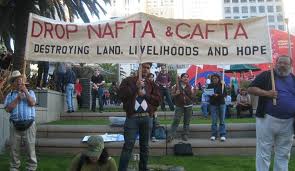The North American Free Trade Agreement (NAFTA) between Canada, the US and Mexico was signed in 1994. It included provision for corporations to sue governments that were party to the agreement if their regulations and policies threatened their investments or trade (see NAFTA ISDS cases).

NAFTA required a large concerted public relations/lobbying campaign to get approval. Over $25 million was spent by US businesses and the Mexican government to promote NAFTA and "a phalanx of Washington law firms, lobbyists, public relations companies and consultants” such as PR firm Burson Marsteller were used in the campaign. They were aided by the conservative think tanks, the Business Roundtable, the National Association of Manufacturers, the Chamber of Commerce as well as major and regional media outlets.
 In preparation for the NAFTA vote the Wexler Group “built and activated a 50-state network of business activists” to support NAFTA; and recruited 4000 companies and associations to join USA*NAFTA. It also “supervised paid grassroots organizers and telemarketing firms, organized weekly meetings of private sector trade experts, senior lobbyists, and heads of Washington offices of the largest US corporations, participated in weekly strategy sessions with corporate, Congressional and Administration leaders responsible for NAFTA”. The Wexler Group was credited with being a leading strategist for getting NAFTA passed by Congress.
In preparation for the NAFTA vote the Wexler Group “built and activated a 50-state network of business activists” to support NAFTA; and recruited 4000 companies and associations to join USA*NAFTA. It also “supervised paid grassroots organizers and telemarketing firms, organized weekly meetings of private sector trade experts, senior lobbyists, and heads of Washington offices of the largest US corporations, participated in weekly strategy sessions with corporate, Congressional and Administration leaders responsible for NAFTA”. The Wexler Group was credited with being a leading strategist for getting NAFTA passed by Congress.
 Opponents included environmental groups such as Greenpeace, Friends of the Earth and the Sierra Club, who were concerned that US corporations would move to Mexico to avoid US environmental regulations. However the opposition was never taken very seriously by the US government in the face of such well-financed and coordinated lobbying.
Opponents included environmental groups such as Greenpeace, Friends of the Earth and the Sierra Club, who were concerned that US corporations would move to Mexico to avoid US environmental regulations. However the opposition was never taken very seriously by the US government in the face of such well-financed and coordinated lobbying.
NAFTA requires regulatory measures to be ‘least trade restrictive’. For example, NAFTA administrators ruled – after appeal from the Canadian maker of the petrol additive MBTE – that California could not ban MBTE from petrol to prevent ground water pollution. This was because banning MBTE was not the ‘least trade restrictive’ way of dealing with the problem of polluted ground water. The alternative of digging up and repairing petrol holding tanks all over the state to stop them leaking into ground water, although expensive, was considered to be preferable because it was less trade restrictive.
Although economists have labelled NAFTA a great success because it has increased foreign investment and trade, Public Citizen has documented a number of severe consequences including:
The lower prices for goods in the US that have resulted from NAFTA have been outweighed by job losses and wage declines for even the middle classes who do not have college degrees.
NAFTA supporters promised strong growth rates for Mexico upon implementing the deal. Yet, since NAFTA took effect, Mexico's average annual per capita growth rate has been a paltry 1.1 percent. After two decades of NAFTA, Mexico has only grown a cumulative 24 percent. In sharp contrast, from 1960 through 1980, Mexico's per capita gross domestic product grew 102 percent, or 3.6 percent on average per year.